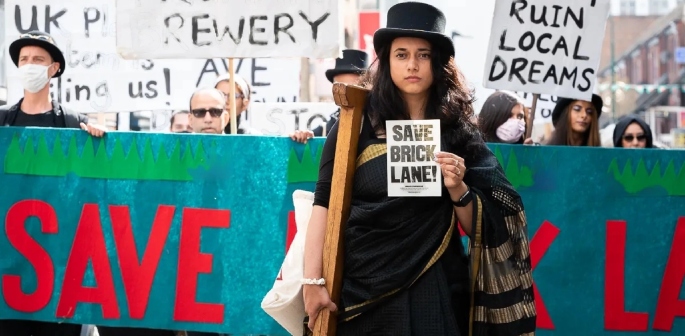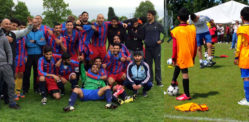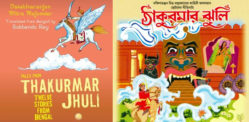These areas were regularly petrol-bombed
In recent years there has been a rise of community grassroots projects aimed at addressing societal concerns often ignored by the government.
A grassroots movement is an initiative that emerges not through a government body but at the community level, by the sheer will of passionate and driven people within those communities.
Regular people can begin their initiatives to bring awareness to ignored or unheard-of issues.
The Bengali population in the UK is around 70,000 as of 2021.
According to statistics recorded by the ONS, the largest Bengali communities are in London, Birmingham, Cardiff and Manchester.
The borough of Tower Hamlets in London has a rich Bengali history. This area of London’s East End also has a long lineage of radical anti-racist resistance.
With this in mind, Nijjor Manush launched in the East End of London in 2018 and caught the public’s attention with their fearless tackling of plans to redevelop Brick Lane.
We will look at what this kind of community project involves, how Nijjor Manush addresses the unique challenges facing their community and the history of the UK Bengali population.
Bengali Community in Britain
The first wave of Bengali immigrants arrived on British shores in the 19th century.
The Bengali migrant men were often involved in maritime trade and arrived in the ports of London, Cardiff and Liverpool.
These sailors primarily originated from the Sylhet region and some chose to settle in Britain.
Bengali migration to the UK wasn’t too significant until later on compared to other Desi communities.
After World War 2 Britain needed to rebuild, so naturally, they called on the countries in the British Commonwealth.
Britain actively recruited workers to address labour shortages. As a result, numerous Bangladeshis migrated to areas like Stepney and Bethnal Green in search of employment opportunities.
In 1971 Bangladesh (previously East Pakistan) celebrated its independence after a brutal war with Pakistan.
Bengali refugees fled to the UK to escape the political turmoil and violence they suffered back home.
Many of the refugees settled in the borough of Tower Hamlets in London’s East End.
This migration has led to Tower Hamlets having the largest population of British Bangladeshis in the UK.
Tower Hamlets’ most famous road is Brick Lane.
Brick Lane became a hub for Bangladeshi immigrants especially in the 70s after the large influx of refugees after the Bangladesh Liberation War.
Brick Lane is a now famous road known for its curry houses and rich cultural diversity.
Locals refer to this area as ‘Banglatown’ and it is marked by lamp posts painted in red and green.
Banglatown was established to recognise Brick Lane’s importance as the heart of the British Bangladeshi community.
At its peak in 2008, around 60 outlets sold Indian, Bangladeshi, or Punjabi food.
History of Radical Campaigns in the East End
The varied communities who immigrated to the East End of London throughout the 19th century included French protestants, refugee Jewish communities, Hans Chinese communities and freed slaves from America.
The area was a hotbed for anti-racist activism and anti-imperial movements to flourish, owing to the cultural diversity of the people living together side by side.
They had to counter the rise of groups such as the National Front in the 70s and other similar movements.
Additionally, lots of well-known social projects such as the Salvation Army, Citizens Advice Bureau and even the Suffragette Movement were founded in or influenced by this area.
As explained on Whitechapel LDN by Cormac Kehoe:
“When the British State tightened immigration laws in the mid-1970s, [many of these] men brought their families to London, fearing that the new restrictions on freedom of movement could permanently separate them from their kin.”
The squatter’s movement began on December 1, 1968, when a small “group of homeless people and libertarian anarchists” occupied the roof of a set of luxury flats in East London.
The activists were protesting against an abundance of empty properties in stark contrast to rampant homelessness.
This type of direct action led to a wave of similar actions nationally and then further into Europe.
Despite less-than-ideal social conditions, immigrant communities living in the East End of London began to find their voices and power.
The Bengali squatters movement arose out of a desperate need for housing.
Bengali families had a hard time getting approved for council housing so they ended up living in privately rented, overcrowded slum-like conditions.
Throughout the 70s, areas like Spitalfields and Whitechapel became an ideological battlefield.
Squatting was yet to be criminalised in Britain, thus empty buildings in these areas started being filled with squatters.
The number of squatters grew exponentially.
This led to the formation of The Bengali Housing Action Group (BHAG) which was organised with the support of radical black campaigning groups and Tower Hamlets Squatters Association.
This growing community mobilisation worried the political establishment at the time.
It’s easy to forget this was around the period in history when Enoch Powell gave his famous ‘Rivers of Blood’ speech.
The BHAG began supporting locals against eviction from the slum squats. Vigilante patrols protected the squats from racist attacks.
These areas were regularly petrol-bombed by the National Front. At one point Greater London Council cut the gas supply in the hopes of deterring the residents’ resolve.
Eventually, due to the sheer will and consistency of the communities living there, the Greater London Council announced an amnesty.
Who are Nijjor Manush?
According to the Nijjor Manush website, they aim to celebrate the “rich histories and political self-organisation of the diaspora”.
They also aim to challenge “the issues facing women, working-class communities and people of colour today.”
The group draws inspiration from previous generations in their communities who fought fascists.
They uplift and celebrate the legacy of political and community activism while striving to continue it. They also state:
“While recognising the many contributions and legacies of the diaspora in the UK and the essential advocacy and cultural work that organisations continue to do, Nijjor Manush recognises the space for a radical, diasporic voice that is political, educative and supportive.”
They explain that their work is aimed at two key areas – radical histories and critical intervention.
They attempt to maintain the cultural histories of their parents’ struggle and combat the sometimes discriminatory attitudes aimed at Bengalis and by extension brown people.
The Brick Lane Campaign
As explained by Nijjor Manush:
“Spitalfields has suffered a tsunami of soulless corporate development spreading from the City of London, inflicting ugly steel and glass blocks at odds with the narrow streets of old brick buildings here.
“First, it was Spitalfields Market, then the Fruit & Wool Exchange and Norton Folgate.
“Now the wave has reached the Old Truman Brewery.
“Despite local protests, the City of London has successfully used its power to impose land grabs, expanding its financial industries into Tower Hamlets.
“The Fruit & Wool Exchange was home to small local businesses that have been replaced by an international law firm with vacant shops beneath
“Councillors voted unanimously to reject the Fruit & Wool Exchange and Norton Folgate developments but were overruled by Boris Johnson, then Mayor of London, who used his powers to approve the proposals on behalf of the City.”
The Save Brick Lane campaign aims to preserve the architecture of the area along with its cultural and historical background.
The locals are fighting to preserve their histories in the face of rapid gentrification.
Nijjor Manush arose organically in the heart of an important London area learning from successful historic direct action movements.
Organisations like this are vital to providing a voice for an often overlooked demographic.
Nijjor Manush refuses to be overlooked and they champion causes on behalf of the Bengali community.
In doing so this movement has not only galvanised local Bangladeshis but opened a dialogue so that people of all backgrounds can learn and empower themselves.
Social cohesion and shared local history are being fractured and stifled by the redevelopments proposed in Brick Lane.
It is far too often forgotten the importance of the strong community support that places like Banglatown provide for British Bangladeshis.
The inspiration taken and the respect this younger generation has for the struggle of their immigrant ancestors is displayed through Nijjor Manush’s work.
This is a movement that should get recognition and applause for radically opposing oppressive policies whilst celebrating their culture proudly.
































































